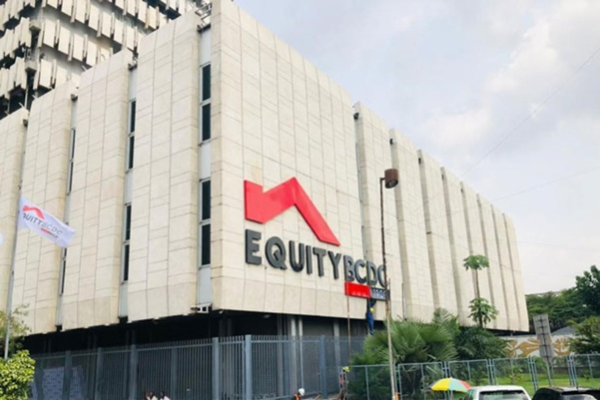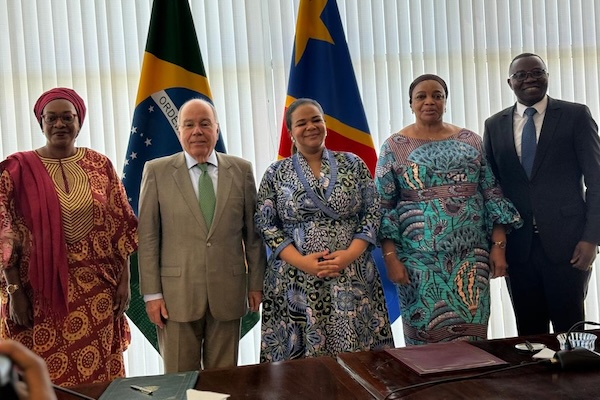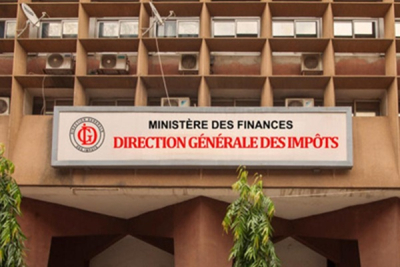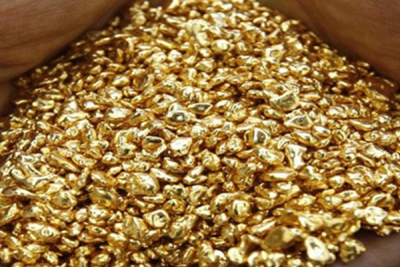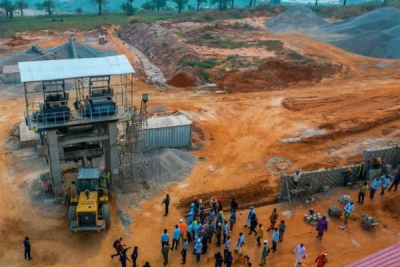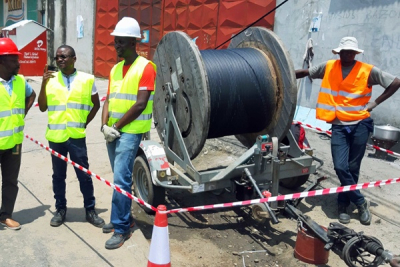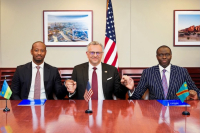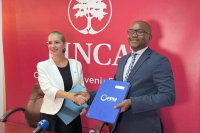
News (571)
-
Net Profits in H1 stands at 9.1 billion KES (71.4 million USD).
-
The Congolese subsidiary now the second-largest contributor to Equity Group earnings.
-
Loan portfolio rises 13% to 275.4 billion KES (2.16 billion USD); shareholder equity grows 28% to 82.6 billion KES (648 million USD).
Equity BCDC, the Congolese subsidiary of Kenya-based Equity Group Holdings, recorded a net profit of 9.1 billion Kenyan shillings (71.4 million USD) in the first half of 2025, a 22% increase over the same period in 2024.
The figures highlight the strength of Equity BCDC, now the second-largest contributor to Group earnings after Equity Bank Kenya, accounting for 26.3% of total profits (34.6 billion KES). The Kenyan subsidiary remains the largest contributor at 56.4%, while other regional units and the insurance arm showed mixed results.
Equity BCDC continues to expand its lending operations, with a portfolio rising 13% to 275.4 billion KES (2.16 billion USD), making it the largest regional subsidiary in loan volume, representing 33.4% of the Group’s total.
The Congolese subsidiary is also strengthening its financial stability. Shareholders’ equity increased 28% to 82.6 billion KES (648 million USD), reinforcing confidence despite occasional internal social tensions in the DRC.
Timothée Manoke (intern)
Read Also:
Equity BCDC: Unions decry a "disguised layoff" targeting 460 agents.
Equity bets on DRC for growth, despite regulatory constraints.
Insurance in DRC: Equity targets a market with great potential.
Highlights:
• Kinshasa and Brasília sign multiple agreements covering visas, diplomatic work, and military cooperation.
• Collaboration expands to agriculture, health, environment, and electoral projects.
• Trade reached a record $259 million in 2024, up 28% from the previous year.
The Democratic Republic of the Congo (DRC) and Brazil signed several agreements and memorandums of understanding on August 11, reinforcing diplomatic, security and economic cooperation, the DRC government said.
The agreements include visa exemptions for holders of special passports and authorization for paid work for diplomats’ dependents. In the security sector, both countries pledged to strengthen the operational capabilities of the DRC Armed Forces (FARDC), acquire equipment, exchange expertise in the military industry, and train special jungle units.
“The signing of these agreements testifies to the shared desire of the two States to consolidate their diplomatic relations in the service of the well-being of their peoples,” the DRC Ministry of Foreign Affairs said on X.
The countries also collaborate on strategic sectors including agriculture, health, biofuels, environment, and elections. A technical cooperation program launched in 2022 trains small-scale Congolese agricultural producers.
Trade between the two nations hit a record $259 million in 2024, up 28% against 2023. Last year, Brazil exported $191.5 million worth of sugar, poultry, and pork to the DRC while the Central African nation exported crude oil valued at $67.6 million. In 2023, Félix Tshisekedi became the first Congolese president to pay an official visit to Brazil.
Lydie Mobio
Highlights:
• Tax breaks for mining, oil and industry cost over 3% of GDP in 2023
• Exemptions absorb 75% of lost revenue, but jobs grew just 3% in 2024
• World Bank urges targeted incentives, more transparency and efficiency
The Democratic Republic of Congo (DRC) grants significant tax exemptions to the mining, oil and industrial sectors, but their impact on employment remains limited, according to the World Bank’s report “Reassessing Tax Incentives – Far from the Promised Growth and Equity” published at the end of July 2025.
The report estimates that tax expenditures, mainly from corporate income tax (CIT) and value-added tax (VAT) exemptions, accounted for over 75% of lost public revenue. In 2023, they represented 1.6% of GDP for the mining sector, 1.5% for oil and 0.7% for industry. By contrast, employment grew only 3% in 2024, with the labor market still dominated by informality and insecurity.
Although the DRC’s corporate tax rate of 30% is above the African average of 28%, the country offers temporary exemptions of three to five years in certain economic zones, coupled with customs and tax benefits. But the World Bank warns that these schemes are “often poorly targeted and profit-based,” distorting investment choices and even encouraging companies to delay projects until exemption periods expire.
Instead, the institution recommends replacing broad exemptions with targeted measures such as accelerated depreciation, while broadening the tax base and ensuring greater transparency. It further calls for rationalizing tax expenditure, harmonizing rates and strengthening budget analysis to enhance efficiency, equity and domestic revenue mobilization.
Ronsard Luabeya
-
Kibali produced 306,667 ounces in H1 2025, below the half-year target of 344,000–377,500 ounces.
-
Production is down 13% year-on-year due to lower ore grades and operational challenges.
-
Strong gold prices boosted revenues despite lower output
The Kibali gold mine in Haut-Uélé province, DRC, produced 306,666.6 ounces (8,693.8 kg) of gold in the first half of 2025. Barrick Mining, the mine’s operator, reported the figure on August 11. This output falls short of the half-year target of 344,000–377,500 ounces and marks a 13% decline compared with 351,111 ounces in the same period of 2024.
AngloGold Ashanti, which holds a 45% stake in the mine alongside Barrick, attributes the decline to lower ore grades. “Operational difficulties have reduced the amount of underground ore available for processing, increasing the use of lower-grade open-pit ore,” the company said. Barrick had previously forecast higher underground grades later in the year, but this has not yet materialized.
Despite the production drop, high gold prices have bolstered revenue. Kibali’s first-half average selling price is forecast at $3,099 per ounce, up from $2,213 a year earlier. The mine generated $702.2 million in sales in 2024, and analysts from Canadian firm Fidelity anticipate gold could reach $4,000 per ounce by year-end, supporting Barrick’s revenue growth even amid lower output.
This article was initially reported in French by Pierre Mukoko
Adapted in English by Ola Schad Akinocho
-
The Katanda plant in Kasaï Oriental will have an annual capacity of 1.2 million tonnes, with the first phase producing 300,000 tonnes.
-
Cement prices in the province could fall from $24–30 per 50 kg bag due to local production.
-
Combined with Cilu acquisition, WIH Cement could become the DRC’s leading cement producer with 2.2 million tonnes capacity.
The cement plant under construction in Katanda, Kasaï Oriental province, is scheduled to begin production in February 2026, according to interim governor Dr. Augustin Kayemba Mulemena during his inspection of the site on August 8.
Construction, which started in August 2024, currently focuses on the life base and staff offices. Some equipment has already arrived in Lubumbashi, while the remainder is expected from China by the end of August 2025. Foundations for steel structures, essential for the installation of production machinery, are underway.
The plant’s first phase, estimated at $400 million, will produce 300,000 tonnes per year, gradually increasing to its full 1.2 million tonnes capacity. Local cement prices, currently around $24 per 50 kg bag and rising to $30 at times due to logistical challenges, are expected to decline once production starts.
With this plant, the DRC could narrow its cement deficit, which stood at over 260,000 tonnes in 2023, according to the Central Bank of Congo. Coupled with WIH Cement’s acquisition of a 91% stake in Cimenterie de Lukala near Kinshasa, the company could reach a combined production capacity of 2.2 million tonnes per year, positioning it as the country’s leading cement producer.
This article was initially reported in French by Timothée Manoke (intern)
Adapted in English by Ola Schad Akinocho
-
Airtel Africa and Vodacom announced a strategic network-sharing agreement on August 12, 2025.
-
The partnership aims to expand coverage, improve connectivity quality, and reduce infrastructure costs.
-
In the DRC, Airtel leads the mobile market with 35.5% revenue share, followed by Vodacom at 32.6%.
Airtel Africa and Vodacom Group have struck a strategic agreement to share network infrastructure across the Democratic Republic of Congo (DRC), Mozambique, and Tanzania, pending regulatory approval. Announced on August 12, the collaboration pools fiber optic networks and mobile towers to accelerate digital service rollout, cut infrastructure costs, and enhance connectivity quality.
By leveraging their combined assets, the operators aim to expand coverage to rural and underserved areas and provide customers with more reliable 4G and 5G services. Vodacom CEO Shameel Joosub emphasized that the partnership will connect more people faster and at lower cost, ensuring "no one is left behind in the digital age." Airtel Africa CEO Sunil Taldar highlighted the shared goal of widening access to digital opportunities, even in remote regions.
In the DRC, Vodacom has already partnered with Orange to install solar-powered mobile base stations in rural areas, while Airtel Africa recently teamed up with SpaceX to offer Starlink broadband services. Last year, Airtel led the DRC mobile market with $741 million in revenues (35.5% market share), followed by Vodacom with 32.6%, Orange at 28.1%, and Africell at 3.8%.
This article was initially reported in French by Boaz Kabeya
Adapted in English by Ola Schad Akinocho
- CPVS says contract with new firm will “start from scratch” after Afritech exit
- Ghana’s Margins Group seen as frontrunner; built Ghana Card system
- Project halted in 2024 after $444 mln overbilling concerns
The Democratic Republic of Congo (DRC) is preparing to sign a contract with a Ghanaian company to produce national identification cards, the Presidential Strategic Oversight Council (CPVS) said on July 25. The deal, reportedly with Margins Group, is in the final stages of negotiation following the termination of a previous agreement with Afritech in August 2024.
CPVS coordinator François Muamba Tshishimbi and National Population Identification Office (ONIP) director Richard Ilunga recently confirmed the new partnership but gave no further details on the selection process. Margins Group, founded in 1990 in Accra, developed Ghana’s biometric “Ghana Card” and has had its proposals under review in Kinshasa for months.
The project will begin from scratch, combining administrative registration with targeted categorization of groups such as students, military personnel, Congolese abroad, and refugees. More than 5,000 permanent offices are planned nationwide, with cards provided free of charge unless lost or renewed.
National ID issuance resumed in DRC in 2022 after a 40-year hiatus, starting with a pilot that produced around 700 cards in Kinshasa. The earlier project—awarded in September 2023 to Malian businessman Samba Bathily’s Afritech, working with French biometric firm Idemia—was cancelled in 2024 following a Finance Inspectorate (IGF) probe. The IGF cited $444 million in overbilling, particularly in real estate costs, and flagged irregularities in the financial structure.
Ronsard Luabeya
• The DRC and Rwanda initialed a new regional economic integration framework on August 1, as part of the June 27 peace agreement.
• The framework aims to formalize mineral supply chains, curb illicit trade, and improve local benefits from resource exploitation.
• U.S. investors are closely watching the process, with strategic minerals and transparency topping the agenda.
By initialing the "text of principles" for a regional economic integration framework in Washington on August 1, 2025, the Democratic Republic of Congo (DRC) and Rwanda have taken a tentative but meaningful step toward regulating their shared mineral trade. The document, still confidential, is a follow-up to the peace agreement signed between the two countries on June 27 and is expected to pave the way for greater transparency and regional cooperation.
The framework is described as building upon existing African integration efforts, including the African Continental Free Trade Area (ZLECAf), the International Conference on the Great Lakes Region (CIRGL), the Economic Community of the Great Lakes Countries (CEPGL), and the East African Community (EAC).
According to the peace agreement, the two countries are expected to leverage the framework to "develop foreign trade and investment from the region’s supply chains of critical minerals and introduce greater transparency." The underlying goal is to dismantle illicit circuits that have long fueled regional instability and to promote inclusive prosperity through formalized and regulated resource flows.
This move could mark a turning point in the informal mining trade between the DRC and Rwanda, which has been the subject of multiple UN reports alleging illegal trafficking of minerals — including gold, coltan, and tantalum — mined in eastern DRC and re-exported via Rwanda under new labeling.
American interests in the firing line
For Kinshasa, the formalization process represents an opportunity to recapture lost revenues and align its resource exports with international standards. This is particularly relevant for minerals extracted in conflict-affected regions, which often face scrutiny under global sourcing regulations.
The United States, for its part, has expressed support for the initiative and is engaged in parallel talks with the DRC for a dedicated agreement on strategic minerals. U.S. companies such as Kobold Metals and Starlink are already present in the country, and the Biden administration sees regulated supply chains as critical to both commercial and geopolitical interests.
According to sources close to the talks, a more detailed final agreement is expected by September 27. The rollout of the new regional framework is to begin within three months of the peace agreement’s entry into force, although implementation is likely to be phased.
Whether the text of principles leads to concrete, enforceable changes will depend on political will, investor confidence, and the ability of both countries to implement cross-border oversight mechanisms without reigniting old tensions.
This article was initially reported in French by Pierre Mukoko
Edited in English by Ola Schad Akinocho
FINCA RDC, a microfinance institution operating in the Democratic Republic of Congo, has secured $8.2 million in funding from the Fund for Financial Inclusion (FPM SA), marking a significant boost to its credit capacity. The agreement, signed on July 29, aims to bolster FINCA’s lending portfolio and extend its reach to more micro, small, and medium-sized enterprises (MSMEs) across the country.
The financing package includes $6.2 million in senior debt and an additional $2 million in subordinated debt. Mirela Pekmezi, FINCA’s Managing Director, emphasized that the capital infusion will strengthen the institution’s equity base while preserving liquidity, allowing for sustainable growth within the underserved MSME sector.
This injection aligns with FINCA’s broader strategy focused on financial inclusion and expansion. Its latest Pillar III report from 2024 reveals a 14% increase in its loan portfolio, valued at approximately 293.8 billion Congolese francs—equivalent to over $100 million—driven by a jump in loans issued from just over 51,000 in 2023 to more than 70,000 the following year.
For Patrick Nkongo, Managing Director of the Fund for Financial Inclusion in the DRC, the partnership with microfinance leader FINCA offers a powerful lever to deepen financial inclusion nationwide. Leveraging FINCA’s significant geographical footprint, the fund aims to extend credit access in areas often neglected by conventional lenders. This collaboration aligns with FPM’s ongoing strategy to sharpen its focus on refinancing mechanisms, portfolio guarantees, and credit lines, working alongside institutional donors such as the World Bank and KfW.
Reflecting the momentum, FPM’s latest Pillar III report for 2024 reveals that outstanding loans have jumped 53.4%, reaching $50.4 million.
This article was initially published in French by Ronsard Luabeya
Edited in English by Ange Jason Quenum
The Democratic Republic of Congo (DRC) recently formalized its third partnership with a European football club, signing a four-season deal with FC Barcelona starting this year. This latest agreement, announced by the Catalan club on July 30, 2025, follows two earlier deals with AS Monaco, a three-season agreement signed in June 2025 and set to begin with the 2025-2026 season, and an initial three-year deal with AC Milan made official in October 2024, set to begin in 2026.
None of these contracts has been publicly disclosed. However, international press reports estimate the DRC's total commitments at €89.8 million, or more than $100 million at the current exchange rate.
Specifically, the DRC has pledged €43 million to FC Barcelona. According to Jeune Afrique, €10 million has already been disbursed for the 2025–2026 season, with payments increasing by €500,000 per season to reach €11.5 million in 2028–2029. Several sources indicate an annual amount of approximately €1.6 million for AS Monaco. For the AC Milan agreement, Le Monde reports a valuation of €14 million per season, totaling €42 million over three years.
These initiatives have sparked criticism within the DRC. Many observers denounce investments abroad while local football faces a crisis marked by deteriorating infrastructure. On social media, numerous citizens believe these funds would be better spent on basic needs such as water, electricity, and healthcare.
Authorities, however, contend these partnerships are part of a broader strategy. They are included in the DRC’s overall strategic communication plan, aiming to strengthen the country’s soft power, promote its international image amid conflict in the East, and attract investors and tourists. The AC Milan agreement, signed by Tourism Minister Didier M’Pambia Musanga, specifically seeks to position the DRC as a tourist destination, with ambitions to raise tourism’s contribution to GDP from 5% to 10%, mirroring Tanzania's growth.
Beyond international promotion, these agreements also include support for local sports development. FC Barcelona's partnership, for instance, covers sports activities like football, basketball, handball, futsal, and roller hockey through its Barça Academy and Barça Innovation Hub programs. The AC Milan agreement involves launching a football academy in Boma, in partnership with the Mama Sofia Foundation.
Timothée Manoke (Intern)
More...
Foner, the National Road Maintenance Fund, will begin collecting an annual axle load charge in Kongo Central province, its Deputy Director General Georgine Selemani announced on July 23, 2025, during a meeting with Governor Grace Bilolo.
The tax, stipulated in Article 16 of the July 7, 2008 law establishing Foner, primarily targets heavy-duty trucks. Although an interministerial decree of March 6, 2009, defined its implementation procedures, the tax has never been enforced. The 2022 Foner annual report, released in June 2024, continued to list this charge among the institution's inactive revenue sources.
In accordance with Articles 24 and 25 of the implementation decree, this charge applies to vehicles with a useful weight exceeding 3.5 tons, specifically trucks and heavy transport machinery. The amounts are expressed in U.S. dollars but payable in Congolese francs. They vary by vehicle configuration: $185 for two axles, $270 for three axles, and $340 for articulated vehicles.
According to Georgine Selemani, the measure aims to ensure the durability of road infrastructure, which heavy trucks frequently use. She emphasized the charge's importance in securing stable funding for road network maintenance, Foner's primary mission. However, she did not specify why collection is starting in Kongo Central. This province hosts the port of Matadi, the main entry and exit point for goods to and from Kinshasa and the rest of the country.
Awareness Campaign
A campaign to distribute regulatory texts is planned before the charge collection begins. This awareness initiative will specifically target economic operators, including members of the Federation of Congolese Enterprises (FEC), to inform them about the charge's implementation procedures. However, no details were given regarding the campaign's start date or the tax's actual effective date.
Beyond the fiscal issue, the meeting between Foner and the provincial government provided an opportunity to review the progress of ongoing roadworks in Kongo Central. Several projects, assigned to the Road Office, are currently on hold due to administrative delays or lack of funding.
Foner reaffirmed its commitment to mobilizing the necessary resources to restart some of these projects to improve accessibility and road network quality in the province.
Established by the same 2008 law, Foner is responsible for mobilizing resources for the maintenance and protection of national, provincial, and urban roads. Its main funding sources include levies on fuels such as gasoline, diesel, and liquefied petroleum gas, as well as toll charges, weigh station operations, the axle load charge, and penalties related to the abusive use of the road network.
Ronsard Luabeya (Intern)
Indian engineering firm Angelique International Limited (AIL) plans to set up a tractor assembly plant in the Democratic Republic of Congo (DRC). The company announced this on July 24, during a meeting with DRC’s Minister of Industry, Louis Watum Kabamba.
Devang Akbari, AIL’s representative, said they discussed several technical aspects of the project during the meeting. He added that the company is preparing a detailed technical and financial proposal to submit soon. Akbari noted that Minister Kabamba gave clear instructions on how to move forward. The relevant departments will conduct a technical evaluation before finalizing any formal agreement.
Angelique International, which specialises in engineering, procurement, and construction (EPC), operates across several African countries. It has already set up tractor and agricultural equipment assembly plants in Benin, Chad, Sierra Leone, Togo, Cameroon and South Sudan.
In the DRC, the company is already active in the energy sector. It led the first phase of the Kakobola dam project, which included the design, turbine installation, and construction of the power plant. Although the project started in 2011, it faced delays and resumed in 2020. The final phase focuses on power transmission and distribution.
AIL also signed a memorandum of understanding on July 23 with the National Electrification Agency (ANSER). The deal covers the construction of a 26.8 MW hydroelectric plant.
This article was initially published in French by Ronsard Luabeya (intern)
Edited in English by Ange Jason Quenum
Quest Water Global Inc., a Canadian company specializing in sustainable water treatment and distribution, announced on July 24, 2025, it signed a public-private partnership with the National Office for Rural Hydraulics, or ONHR. The ONHR is an entity under the Democratic Republic of Congo’s Ministry of Rural Development.
The $30 million agreement calls for installing 300 Aquatap potable water stations across five provinces, benefiting nearly 1.8 million people. The stations will deploy in Kinshasa, Kasaï, Bas-Congo, Haut-Katanga, and Lualaba, areas with largely insufficient water infrastructure.
The deployment will follow a Design-Build-Finance-Operate-Transfer, or DBFOT, model. Under this model, Quest Water will handle the design, financing, manufacturing, operation, and eventual transfer of the facilities to the Congolese state. In return, the Congolese government commits to providing land, ensuring installation security, facilitating administrative procedures, and granting tax exemptions on imported technological equipment.
The 10-year project includes manufacturing units in South Africa and an assembly plant in Kinshasa. A local joint venture, Aquatap Oasis Partnership SARL, will handle on-the-ground implementation. Revenue from water sales will be shared, with Quest Water receiving 60% and the ONHR 40%.
This project is part of the Congolese government’s efforts to improve water access in rural and peri-urban areas. The ONHR, a public agency responsible for planning and monitoring rural water projects, will coordinate.
Beyond water access, the initiative is expected to create several hundred direct and indirect jobs, from site identification to equipment maintenance. Hygiene and sanitation awareness campaigns, known as WASH, will also be carried out with support from the U.S. based NGO Clean International.
Quest Water Global, founded in 2010 in North Vancouver, operates in North America, Latin America, the Caribbean, and Africa, including the Democratic Republic of Congo, Angola, and South Africa. It develops solutions such as Aquatap, a decentralized solar-powered water purification and distribution system, and WEPS, which produces drinking water from atmospheric humidity.
This is not the company’s first venture in the Democratic Republic of Congo. In 2019, it signed an agreement with American Ventures, founded by former basketball player Mutombo Dikembe, and Kalo Products SARL to install 50 community water centers in Tanganyika, Lualaba, Sud-Ubangi, and Kasaï provinces.
Ronsard Luabeya (Intern)
Twenty-nine new oil blocks cover 72% of the Kivu-Kinshasa Green Corridor, a protected ecological zone.
The Green Corridor spans 544,270 km², aiming to protect over 100,000 km² of primary forest and promote a green economy.
Environmentalists warn oil exploration threatens the project’s climate goals and international reputation.
The Democratic Republic of Congo (DRC) balances two conflicting ambitions: becoming a major oil producer while solidifying its role as a climate change solution country. A June 20, 2025 map analysis by NGO Earth Insight reveals 29 newly auctioned oil blocks overlap 72% of the Kivu-Kinshasa Green Corridor.
Created on January 15, 2025, the Green Corridor aims to position the DRC as a global leader in combating climate change. The corridor covers 544,270 km²—over a quarter of the nation—and protects more than 100,000 km² of primary forests. Its founding decree mandates that any new economic projects within the corridor align with this green vision. However, oil extraction directly contradicts this goal.
In December 2024, Deputy Prime Minister and Environment Minister Ève Bazaibatold Deutsche Welle that mining permits granted inside the Green Corridor would be revoked. Since 2018, the state oil company Comico holds three blocks in Équateur province, including Busira and Mbandaka, which lie inside the corridor boundaries defined in 2025.
Hydrocarbons Minister Aimé Sakombi Molendo responded to criticism in Jeune Afrique by stating that the auctioned blocks had been “detoxified” to exclude protected zones. The government maintains it will not back down, aiming to balance exploration and production with safeguarding future generations’ interests.
Earth Insight strongly challenges this approach. The NGO argues that auctioning fossil fuel concessions within the Green Corridor undermines its international credibility and breaches commitments to biodiversity and climate action. The stakes are high given the corridor’s dependence on outside funding.
President Félix Tshisekedi estimates the project needs one billion dollars over three to four years to succeed. In January 2025 at the World Economic Forum in Davos, he showcased the Green Corridor and secured pledges from the European Union and Team Europe initiative to mobilize one billion euros in support for the community-based protected area.
Timothée Manoke, intern






